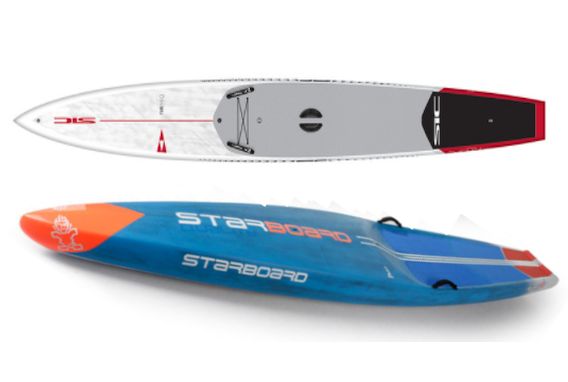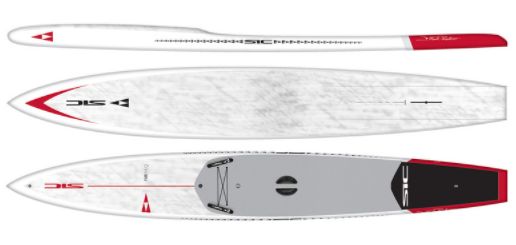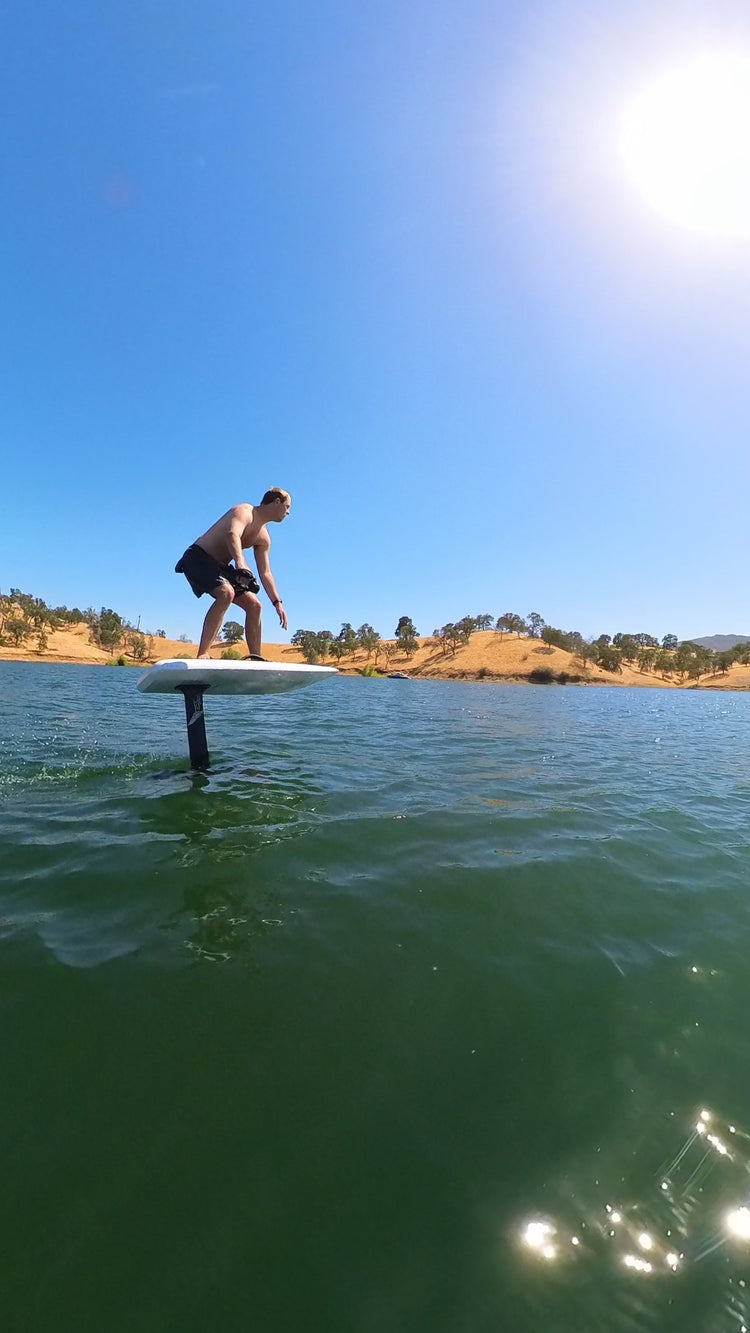

One of the best perks of this job is riding all the new gear just as it hits the water. As avid paddle racers ourselves it is with great anticipation we awaited the new race designs. Well they are here!
And this year in particular we have been on the edge of our seats waiting for SIC’s new Rocket Ships (aka the RS boards). Well our fleet of boards arrived about a month ago and we have been putting them through their paces.
A little baseline first to understand some context for where our point of view is coming from. We paddle in the very diverse waters of San Francisco Bay. In general, our conditions are rougher than most, favoring boards with softer rails and accentuated rocker lines. For example, we really don’t carry too many of the Starboard Sprints. Not because they aren’t great boards but because we literally do not have the kind of water needed to enjoy them. So, a board that does not work here may be awesome for your location. (i.e. an inland lake)
The benchmark in measuring SIC’s new race board is the Starboard All Star. We have been riding & racing the All-Stars since they came out and they are incredible boards. We have not had the chance to fully vet the 2018 All Stars so we will be comparing the SIC to the 2017 boards with which we have extensive water time. In general, we see that the 2018 All Star will be faster than the 2017 in flat water but that we feel the 2017 is better than the 2018 in rough water. It’s mainly the change to the front of the 2018 All Star that makes the difference when comparing to the 2017. The 2018 has sharper rails and more volume up front. This tighter entry of nose in the 2018 will make the board faster in a straight line but more difficult to control the nose when the going gets rough.
The 2018 All Star in our opinion is a little better of a one-board quiver, where the 2017 is more specialized in its design brief; a rough water racing machine. On a side note the 2018 Sprint seems to be better suited for rougher waters than the 2017 Sprint which is more of a flat-water sled. The 2018 Sprints increased tail volume will be an asset to those wanting an ultra-fast board that can still take on some texture on the water.
Another point to make when talking about these boards it that they are all different. We mean that even with within the lines of one brand. So, the 26” All Star for example is a different board than the 23” All Star. They are not simply “the same thing just narrower”. Rails Change, Volume Flows change, even fin box locations change. Changing a fin box location is a big deal. One more point to make. There is no ‘winner’. Every time a design choice is made it has a consequence. A pro and a con. The point here is not to say who is better but rather to translate these choices the designers are making so you can pick the board that is best for you.
The key to picking the right board for you is matching it to not only the venue you race in most often, but also the skill of the rider. While a pro rider may be able to benefit from a design element that very same design choice may put the intermediate racer in to the water. The SIC boards are more similar to each other than the All Stars. In the Starboard line the 24.5 is quite different from any other All Star. Designed to be a downwind racer the 24.5” All Star it is quite different from the 24.5 SIC RS or even the 23” All Star. The 24.5” All Star has a much taller rider position in the cock pit and has moved the fin box forward. These two elements will shine in down hill conditions but as we have mentioned will have consequences to stability and speed when paddling vs. downwind surfing.
One interesting paradox is that the SIC also has a forward mounted fin box but does not have the same looseness in the tail. We credit that to the sharpness of these small channel edges in the tail. These work and work well (note you can also find a similar bottom on the Infinity Blackfish – almost a merge of the two boards. We are also chomping at the bit to get a ride on the new Jimmy Lewis Sidewinder which has a new design that looks quite effective.) At first, we couldn’t believe it, but these small grooves really work. As a side benefit they allow the tail to release in slow speed buoy turns. The lower nose weight and looser tail (when stopped) make the SIC the better buoy turning board. Those chamfers on the All Star hold the tail when you are trying to slide it through the turn. So, the SIC tail is more locked in when at speed and loose when stopped. The translation here is you can have your cake and eat it too.
That was a lot of set up for a simple gear review but hopefully sets the tone as we break down these boards. We’ll tackle each of the key performance attributes and give you our findings. We will even sprinkle in some references to the Infinity Blackfish. While don’t have the hours riding them we do on the other boards we have ridden them, and we are very excited about these boards. And now…….
Flat water over all speed. (full line comparison) The SIC RS Boards are faster than the All Stars in the flat water. Their simple bottoms and tighter entry at the nose makes them move through the water with less resistance. The bottom of the All Star is extreme whereas the RS boards is far subtler. Both designs work and work well but the trade off with respect to speed is due not just to the nose but also these bottom designs. We are very impressed with SIC’s new bottom. It has essentially created a channel down the middle that locks the tail in place and generates more forward speed with less side to side tail slide. So, the twist generated from the stroke is placed in to forward energy more efficiently. It takes about 4 to 6-inch waves for the All Star to star to show the value in all those concaves and chamfers.

Rough water overall speed (full line comparison). The All Star is faster when the crazy gets crazy. At 6 inch or higher waves the All Star is the faster over all board. Breaking down some specifics as to why that is but looking at element by element follows. The one juxtaposition here is that we write this with the recreational racer in mind. A pro rider may be able to ride the SIC faster so what we are saying here is the All Star is easier to ride in rough water and therefore faster.
Stability (23”, 24.5”, 26” All Stars vs 23” and 24.5” RS). The All Star has better stability. Both initial and secondary stability. When we say stability, we are talking specifically about side to side. “Staying on the Board” stability must be accounted for as we look at the other areas of performance where in certain situations the SIC is more stable. Spoiler alert – that is in side winds. For example, upwind stability vs downwind can be different to sidewind stability which we will touch on later. A lot of this has to do with how the bottom designs, tail designs and rail designs were handled.
Before we go much further let’s talk about those bottoms and just what is going on. SIC as we mentioned has this channel down the bottom and more tradition rail designs on the back half of the board. Starboard has a massive single concave that works well in helping propel the board when waves are lifting the board up and down. While the SIC also gives you some squirt it’s not as much as in the Starboard. Concaves however can be slower when constantly being attached to the water. We think this in addition to the SIC tail channel that makes the All Star a little slower in the flats. The Starboards magical stability however is coming from a set of chamfered (beveled) rails in the tail. As the Starboard begins to tip these chamfers act almost as a design element that slows the tipping down. The offsetting characteristic of this design choice is that the tail is little looser and not as locked in as the SIC tail design.

Upwind. In smaller waves the SIC’s piercing nose is faster up wind. As the waves increase the All Star becomes an absolute machine with world class performance. It’s simply incredible. The SIC’s lower volume nose sends it submarining sooner and while a pro rider may be able to work around this the average rider will be riding a board that makes them faster in the All Star.
Downwind – The SIC is faster in the smaller downwind conditions where the All Stars are better on the open ocean. The SIC’s sharp nose makes it harder to control than the more forgiving All Star. One caveat is that the rider with fast foot work will get more speed from the SIC. The All Star however is just easier to ride. One thing of note here is the fun factor. The All Star has the fun factor in its favor. We surf these boards. We are talking waves and sometimes some pretty big stuff. The All Star is soooooo much fun. It can turn and surf really well. The SIC can surf well too but does not want to turn as responsively as the All Star. The SIC simply wants to go straight and resists turning largely as a function of those channels on the bottom. This likely will make the SIC very fast for pro riders are at the helm but most everyone else will be faster on the All Star.
Sidewind. The SIC is the fastest side wind board we have ever paddled. Its soft rail nose and locked in tail make it a dream. The sharper nose allows for better rail steering on the SIC allowing you to edge the board upwind. This can cause problems in that if you lower the windward rail she will bear off faster than the All Star. Now one must note this is the most challenging point of paddle so don’t expect the board to fix all your problems. The All Star is good sidewind board when compared to other race boards, but its looser tail causes it to yaw a bit when being pushed around compared to the SIC. SIC’s lower volume nose also lowers swing weight giving the rider better ability to correct mistakes.
Construction. The All Star, as well as all the other Starboard Race boards, are some of the best made boards on the planet. While a lot of race boards are light lay up egg shell constructions the Starboard is a robust PVC Sandwich. The only other manufacturer with comparably made boards is Jimmy Lewis. You will however pay for this construction with the Starboard coming in at $1000 more expensive. If you plan on keeping your board a long time however that may make the Starboard a better value. Construction also effects performance in two major ways. One is weight and the other is flex. An All Star at the same size is in general 1.5 to 2lbs heavier. Besides the benefit of durability, the Starboard also seems to have a better restorative flex. It’s particularly noticeable when pumping the swell in upwind paddling. With positive legwork the Starboard can be pumped like a skateboard in the transition of a half pipe. Excessive leg pumping on the SIC is not as rewarded. Poorly time pumps can stop the SIC while the All Star pretty much is fool proof. A last note on the durability is that we have these Starboard Carbon boards in our rental fleet and they literally hold up better than our fleet of Glide Rental Boards.The SIC is also a well made board. This years boards feature SCC+ which utilizes innegra to up the durability. In addition both boards are made at Cobra in Thailand. Cobra made boards, in addition to the Kinetic Boards made in Vietnam are simply head and shoulders above the chinese manufactured products.

Overall, we think these are the two best All Around boards on the market. We do have two other favorites for racers in our area. The Naish Maliko (made at Cobra) and the Infinity Blackfish (made at Kinetic) being the two front runners, but that of course depends on what you are looking for them to do. That however, is another blog post and by this point I’d bet you are thankful for that!
Reading a blog post is one thing but riding them tells the story. We try to keep most of these boards in our demo fleet at all times so if you have the time come on down and try them for yourselves.
Boards Tested – 23”, 24.5”and 27” All Stars in 2017 and the 2018 26” All Star against The SIC RS 23”, 24.5” and 26”. All in the 14’ Length.
.

